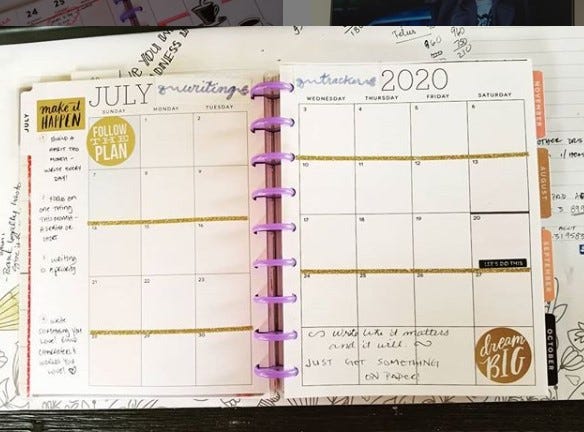Do writers really use planners? Yes, some of us do. Some writers like to create their stories and books by the seat of their pants (they are appropriately called “pantsers”) but for many writers of both fiction and non-fiction, not knowing what they are going to write, who their characters are, and what order events should happen can create writers block. If you’ve ever been at that point, you know how emotionally painful it can be to not be able to write!
If you’ve never had a planner specifically for your writing and you’re interested in trying it out, there are two types of planners I would suggest. Both of them allow you to track and be creative at the same time.
#1 The Bullet Journal
The bullet journal is about “the art of intentional living,” according to its creator, Ryder Caroll. The only two things you need to implement this planning system is a pen and a notebook. You can use any notebook you like. There are many who get creative with their bullet journals by using colored markers or pencils, stickers, and even paint; however, those little extras a not by any means necessary.
Some of the things that are typically included in bullet journals include:
- Index — a list of the pages and collections in your planner
- Future Log — dated entries that are outside the current month
- Monthly Log — dated entries that include a calendar and tasks
- Rapid Logging — quick thoughts and tasks and events in bullet form
- Signifiers — symbols that indicate if it is an event, appointment, deadline, or even just a note
- Collections — focused information about a specific event or topic
- Trackers — to track things that you do on a regular basis
You can get as creative as you want. This is a page from my bullet journal:

There are many ways that writers can use a bullet journal to keep them on track. In the past I have used some of the following features in my writer’s bullet journal:
- Character outlines
- Plot points
- Summaries of scenes
- Word tracker
- Notes on the craft of writing
- Lists of useful websites
- Notes on conversations I’ve had with other writers
This video gives you a basic tutorial of how the bullet journal works:
https://cdn.embedly.com/widgets/media.html?src=https%3A%2F%2Fwww.youtube.com%2Fembed%2Ffm15cmYU0IM%3Ffeature%3Doembed&display_name=YouTube&url=https%3A%2F%2Fwww.youtube.com%2Fwatch%3Fv%3Dfm15cmYU0IM&image=https%3A%2F%2Fi.ytimg.com%2Fvi%2Ffm15cmYU0IM%2Fhqdefault.jpg&key=a19fcc184b9711e1b4764040d3dc5c07&type=text%2Fhtml&schema=youtube
#2 The Happy Planner
If you’re not so good at keeping up with the bullet journal, the Happy Planner might the be right system for your writer’s planner. The months and weekly pages are all set up for you. It’s attractive and functional and there are a wide variety of options to choose from. You can choose different sizes and layouts and you can modify your planner to suit your interest. If you have a Create 365 Happy Planner hole punch, you can even add in your own pages.

You may choose a Happy Planner system that implements your writing plans along with other daily events or you may choose to have an entire planner dedicated to only your writing. it depends on how much information about your writing you want to include in your planner. Whichever option you choose, the Happy Planner can be a lot of fun and can help you stay focused on what is important.
If you want to keep to the basics — things like words written, deadlines, and goals, the monthly calendar at the beginning of each month of a Happy Planner is ideal. It’s a basic calendar with space for some goals.
If you want to get a little more detailed, pick up a Happy Planner with a dashboard layout. There are many options and you can find one you might like on Amazon or on the official Happy Planner site.
The Happy Planner dashboard layouts are perfect when you need a little more flexibility. I have been using a Happy Planner for a few months, but I decided that I wanted to have more space that the monthly calendar for details that would help me get more focused on my writing. I chose the “Choose to Shine” Happy Planner (see below) because it has space for goals, trackers, to do lists, and notes that will give me the space to create my best writer’s planner.

One note about both Happy Planners and bullet journals — if you go on social media you will think that they are more about stickers and highlighters and washi tape than anything else. They do not have to be that way though. If you like that sort of thing, that’s great; however if you are just looking for something that is functional and helps you become more productive in your writing path, don’t feel that you need to use them.
There are many different ways that you can plan. The travellers’ notebook, the Erin Condren system, or if you can’t make up your mind, maybe the frankenplanner — a combination of different planning systems — is right for you!
YywSfAkKVb